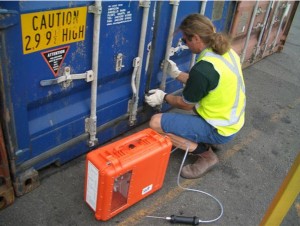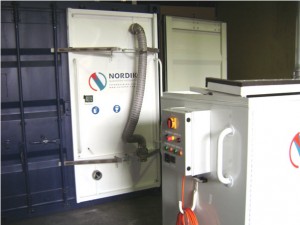POINT OF VIEW
Invisible Threat to Sea Container Inspection Staff
By Wil Grullemans – GM Nordiko Quarantine Systems
The news from an increasing number of international studies and incidents, shows that sea containers often contain highly toxic gases. They are invisible to the eye, and often have no noticeable smell. These gases pose a serious threat to Customs staff that must enter containers to inspect the contents. The types of gases can range from neurotoxins, to carcinogens, and can pose immediate or long term threats to health and safety.
Some customs authorities have already acted on this threat, with Australia, New Zealand, Canada and some European agencies investing in technologies to control the risks. Many other countries are still in the process of building their knowledge base.
Toxic gases accumulate in containers from fumigation or simply through desorption from products during transit, where temperature and humidity changes promote the off gassing process. Fumigant gases include phosphine, hydrogen cyanide, sulphuryl fluoride and methyl bromide. Gases released in transit, from cargoes themselves, include formaldehyde, benzene, ethylene and toluene. These gases arise from wood glues, furniture, coatings, machinery, shoes and many other types of container contents, and can accumulate to dangerous concentrations by the time of inspection.
Containers are identified as being at risk, by taking an air sample through the unopened door seal. This sample is analysed to determine if the air quality inside the container is safe for entry. There are a range of devices for measuring air quality, depending upon the target gas type and local health and safety regulations. Gas monitors come in a cheaper hand-held form with photo ionisation capabilities, or in more sophisticated fixed units using infra-red or mass spectrometry. Improved accuracy and discrimination between gases usually comes at some extra cost.
Between 10% to 20% of containers have been found, through consistent international studies, to pose a threat to inspection staff health. When an unsafe container is identified, a forced ventilation system can be employed to provide fresh air to the container, with contaminated air either being diluted to atmosphere, or scrubbed through a portable filter unit.
The practical aspects of the technology include two major components: gas detection equipment and forced air container ventilation units. Complete solutions are available for every jurisdiction, and the exact configuration will depend on local work air quality regulations, amongst other factors.
On site training in safe and correct use of the technology is provided, and is typically completed within a few days. The cost of the equipment will depend on the customised solution selected ,but should be compared with the consequences of regularly exposing customs officers to toxic gas.
Many large multinational firms now also employ this technology, to protect the health and safety of their container unpacking staff. Presentations will be made at forthcoming WCO events such as the Plenary and Enforcement meetings in Brussels in March 2014, and the equipment can be seen in operation at the WCO IT & Technology Forum in Brisbane, Australia in May 2014.
More Information:

